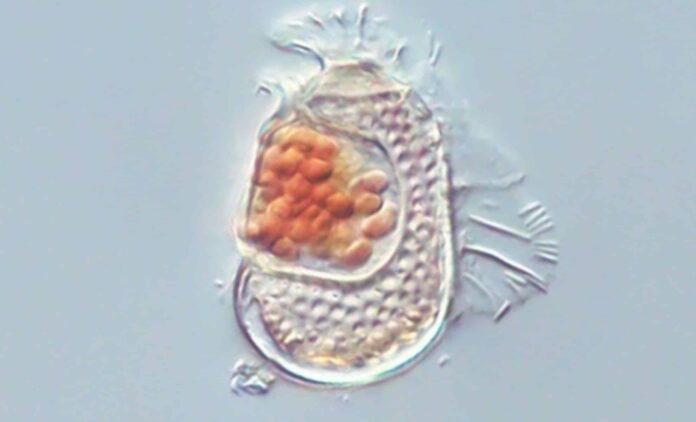A new discovery from scientists in Canada and Japan has revealed an organism that challenges the traditional definitions of life. This new creature, named Sukunaarchaeum mirabile, blurs the lines between a virus and a living cell. While viruses are generally not considered alive due to their reliance on hosts for key biological functions, Sukunaarchaeum exhibits characteristics of both viruses and living organisms. Its unique nature raises questions about the very concept of life itself. The discovery was recently detailed in a paper published on the bioRxiv platform, further pushing the boundaries of how we categorize life in the microscopic world.
A Unique Blend of Life and Virus
The organism Sukunaarchaeum mirabile was discovered while researchers were investigating the genome of marine plankton Citharistes regius. After analyzing a mysterious loop of DNA within the plankton’s genome, molecular biologists, led by Ryo Harada of Dalhousie University, realized that they had found something extraordinary. The genome of Sukunaarchaeum is drastically reduced, with only 238,000 base pairs—roughly half the size of the smallest archaeal genome discovered to date, which spans 490,000 base pairs. This genetic simplicity suggests that Sukunaarchaeum may have evolved to rely heavily on its host for basic functions, despite having the necessary genes to create its own ribosomes and messenger RNA. Unlike viruses, which lack these capabilities, this new organism occupies a space that seems to exist between the viral and cellular worlds.


Challenging the Limits of Cellular Life
The most striking feature of Sukunaarchaeum mirabile is its genome reduction. While viruses are often considered non-living because they cannot perform basic life functions on their own, Sukunaarchaeum can replicate its genetic material and produce proteins, functions typically reserved for living cells. However, as noted by the researchers, “Its genome is profoundly stripped-down, lacking virtually all recognizable metabolic pathways, and primarily encoding the machinery for its replicative core: DNA replication, transcription, and translation.” This minimalistic genome further complicates the distinction between cellular life and viruses. The organism’s reliance on its host for metabolic functions suggests an unprecedented level of dependence, prompting scientists to rethink how they define minimal cellular life.
What It Means for Our Understanding of Life
The discovery of Sukunaarchaeum mirabile holds profound implications for our understanding of life, particularly at the microscopic level. As researchers continue to explore this organism’s biology, they note that it may be part of a larger symbiotic system within marine ecosystems. According to the researchers, “The discovery of Sukunaarchaeum pushes the conventional boundaries of cellular life and highlights the vast unexplored biological novelty within microbial interactions.” This new organism may not only challenge the distinctions between cellular life and viruses but could also offer insights into the evolution of life on Earth. It is possible that this creature represents a new evolutionary path, one that scientists have yet to fully comprehend.
Evolutionary Significance of the Discovery
In the broader context of evolutionary biology, the discovery of Sukunaarchaeum mirabile challenges existing models of how life on Earth evolved. Archaea, a group of prokaryotes that includes the newly discovered organism, are believed to be the ancestors of eukaryotic cells like those in humans. However, Sukunaarchaeum’s extreme genetic reduction and its reliance on its host to carry out fundamental processes suggest that it may represent a transitional form of life. This discovery has the potential to reshape our understanding of cellular evolution, particularly in terms of how simple organisms can evolve unique strategies to survive in diverse environments.
The Unseen World of Microbial Interactions
The Sukunaarchaeum mirabile discovery shines a light on the often-overlooked complexity of microbial life. By revealing how organisms at the microscopic level interact with one another, this research underscores the vast biological diversity that exists within ecosystems. These organisms, which often escape notice due to their size and simplicity, play critical roles in maintaining the delicate balance of life on Earth. Understanding how such microbes interact with their environments—and with each other—may help scientists unlock new insights into everything from microbial ecology to human health.
A Gateway to Understanding the Origins of Life
While the discovery of Sukunaarchaeum mirabile is still in its early stages, it could provide crucial information about the origins of life. By studying this organism’s relationship with its host and the mechanisms it uses to replicate and survive, researchers may gain a clearer picture of the fundamental processes that enabled life to emerge on Earth. This, in turn, could have far-reaching implications for the search for extraterrestrial life. If life forms like Sukunaarchaeum exist in such complex gray areas between viruses and cells, the search for life beyond Earth could look for a broader range of potential life forms.






